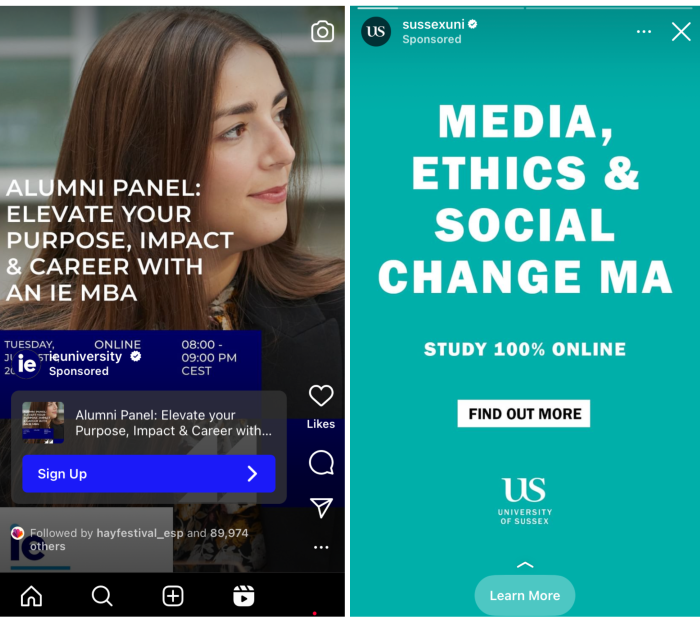Although brand awareness is an essential component of any marketing strategy, it is common for schools to forget about it. This might be because schools don’t see themselves as brands, but a strategy to stand out is a must in a crowded school market. Not only will this help schools position themselves as leaders, but it will also encourage prospective students to explore the offerings available.
But brand awareness is about more than just word-of-mouth promotion. There are many things your school can do to help prospects become familiar with your offerings. One effective way to generate brand awareness is through inbound marketing, which involves a good mix of advertising, email marketing, engaging content creation, social media campaigns, SEO, and consistent brand messaging across different channels. A solid inbound marketing strategy can help you highlight your school’s unique selling points, attract prospective students, and help them move along the enrollment funnel. Here, we’ll explore five ways your school can use inbound marketing to outshine its competitors.
Pre-Audit Consultation for Schools
Could your school benefit from a digital marketing audit?

What Is Brand Awareness and Why It Matters
Within the higher education industry, brand awareness refers to the level of familiarity and recognition the public has with an educational institution and its offerings. This marketing term describes the extent to which a school’s target audience, like prospective students, parents, or the general public, identifies and recalls the school’s brand. As a school, one of your goals should be to ensure that your image is outstanding and associated with positive attributes.
There are different levels of brand awareness that you should be aware of:
- Recognition (or aided awareness): Recognition refers to how prospective students can identify your school when presented with your name, logo, or programs.
- Recall (or unaided awareness): At this level, prospects are familiar with your school’s brand and can recall it when facing a related cue that does not necessarily speak about your school. At this level, you can observe how your school is remembered and what it is associated with.
- Top-of-mind: This is the highest level of brand awareness and indicates market leadership. It refers to the first school that comes to prospects’ minds when considering schools in your industry.
As you can see, brand awareness is fundamental to enhancing your school’s reputation, attracting high-achieving students, and improving your school’s academic profile. In addition, good brand awareness can make your alums feel proud about their alma mater, which fosters their engagement and motivates them to support your institution.
Example: Harvard University is one of the most prestigious universities in the world. Here, a follower and parent of a future student is expressing their pride through a Facebook post.

Source: Harvard University’s Facebook Page
Is your school wondering how to improve inbound marketing? At HEM, we can help you gain brand visibility with our inbound marketing services!
1. Create an Inbound Marketing Strategy to Increase Brand Awareness
Successful inbound marketing starts with an optimal strategy–and if brand awareness is one of your school’s main goals, your inbound marketing strategy should reflect that. When drafting your marketing strategy to increase brand awareness, consider what you want your school to be known for, who is likely to be looking for the programs you offer, and how much budget you can allocate to this goal. Understanding the basics of an inbound marketing strategy can guarantee that you are on the right track and that your efforts will be rewarded.
To generate brand awareness through inbound marketing, you need to know who it is that you want to reach. A strategy that does not have a target audience in mind is a strategy that is designed to fail. Therefore, the first thing you’ll want to do is to research and identify your target personas and their aspirations, needs, and concerns. When writing about your personas, include as many details as needed, such as job titles, income levels, education, hobbies, preferred communication channels, and preferred content formats. Once you have that information, you can map out the enrollment journey for each persona and identify the forms of communication you can use to reach them along the way.
Example: Understanding your target persona and their goals and concerns is essential to create messaging that resonates with them.

Pro tip: Although you may already know what you want your school to be known for, identifying your unique selling points is an important part of the strategy process. As you research your personas, list USPs that are genuine and meaningful to your target audience.
Since you want to stand out among the crowd, branding should also be an essential part of your inbound marketing strategy. Ensure you have a brand voice and a unique aesthetic that allows prospects to remember your school. Ensuring your branding is consistent throughout your channels will help candidates identify your brand wherever they see it. From your logo to the color palette you use, ensure all your inbound teams follow the same guidelines.
Example: Fulford Academy’s branding is consistent across all platforms. This helps prospective students get familiar with the brand and identify it even if the content is shared by accounts that are not the school’s official accounts.

Source: Fulford Academy
Pro tip: If you’ve been wondering how to improve brand awareness and your branding is not strong, you might want to consider working on your branding before creating an inbound marketing strategy.
Another essential thing to remember when working on your strategy is to decide what channels your school would like to use to reach prospective students. Implementing an effective multi-channel approach is essential for enhancing brand awareness, as it enables your school to capture attention from all angles and reach a wider audience. Being everywhere with your audience increases the likelihood of engaging with them effectively and establishing a solid brand presence.
2. Share Compelling Content That Resonates With Your Prospects
Another vital tool offered by digital marketing to enhance brand awareness is content. Providing quality content that speaks about your school’s uniqueness can be an excellent way for your school to position itself as a leader in the industry. Whether through blogs, infographics, or podcasts, your school should find ways to share its story and knowledge with current and prospective students.
Good content speaks to your personas’ concerns while letting them see who you are and what your school is about. It tells your school’s story through compelling narratives. That’s why finding the right voice, tone, and message is as important as understanding what your persona is looking for.
Knowing your audience’s demographics will help you choose the right format. For instance, while Millennials and Gen Z favour short-form video and user-generated content, Gen X prefers blog posts, guides, and email newsletters. If your target audience is composed of different demographics, you can choose different formats to communicate different messages while keeping a consistent voice and branding.
Example: An excellent way to make content more digestible is to present it through an infographic. This format breaks apart information and presents it attractively. Here, Medix College is sharing some tips that could be helpful to its fitness and health students.

Source: Medix College
Pro tip: Content should be shared regularly. Be it weekly, bi-weekly, or monthly, having a consistent content schedule will help your school reach its awareness goals.
A good way to ensure that the content you are sharing is relevant and that is shared on time is by creating and maintaining a well-organized content calendar. Your calendar should include the publishing date, the type of content you will be creating, the title, and the keywords to be included. You could also include the name of the person in charge of researching and creating the content and the person in charge of reviewing it.

Finally, don’t forget to optimize your content for search engines to enhance visibility and share it across different platforms to increase brand exposure. Although search engine optimization might not be the first thing that comes to mind when considering content and brand awareness, schools should remember that SEO helps content reach its full visibility potential. Therefore, researching keywords and optimizing blog websites for SEO is a must.
Example: Matching your keywords with the ones prospects are using can increase the chances that your content reaches the right audience.

Search engine optimization will improve your school’s online presence and help you establish trust and credibility and associate your brand with industry keywords. Creating high-quality SEO clusters can also help schools show prospective students that you are well-prepared to cater to their needs and delve into their areas of interest.
3. Generate Brand Awareness With Top Social Media Content
There are several ways to increase brand awareness on social media, but the first step is defining which platforms your school will use. Although several platforms are available, knowing where your prospects and current students are is key. To get a general idea, you can look at the largest age groups of each of the leading platforms:
- Facebook: 25-34 (29.9%)
- Instagram: 18-24 (30.8%)
- TikTok: 18-24 (21%)
- LinkedIn: 30-39 (31%)
Once you have chosen your platforms, the next step is to create content that appeals to your followers. A good way to generate brand awareness is by creating shareable content such as photos and videos of school events, student recognition and staff appreciation posts, student life highlights, study tips, job search tips, etc. If students, staff members, or other institutions appear in the photos or videos shared, don’t forget to tag them. For instance, in the following Instagram Reel, Ivey Business School talks about things students can do around London, Ontario and tags the accounts of some places and businesses mentioned in the video.

Source: Ivey Business School’s Instagram
Another way to improve brand visibility is by encouraging interaction with your posts and accounts. You could share interactive content like polls, questions, and checklists or ask students and followers to tag you when sharing posts. For instance, you can create a special hashtag and ask students to use it when sharing school-related content. This will promote visibility and make the content more discoverable.
Example: Samuel Merritt University uses the hashtag #SMUShares to encourage students to share their stories and tag the university on their social media accounts. The institution later reposts some of these posts.

Source: Samuel Merritt University’s Instagram
Another great tip is to collaborate with student ambassadors. It is not a secret that student-generated content can improve engagement by providing prospective students with a realistic image of what they can expect to find once they join your school. You can work with ambassadors to generate video content that speaks to your prospective students’ concerns and offers valuable insights to your current students.
Example: In this TikTok video, a University of Toronto student ambassador shows some of the best study spots around the university.

Source: University of Toronto TikTok
Pro tip: Research current social media trends and think about how your school can use them to share helpful information.
4. Take Advantage of Paid Advertising
One of the most effective ways to improve brand awareness is paid advertising. Google, Facebook, Instagram, LinkedIn, and TikTok ads offer immediate visibility by serving your content to the right audience at the right time. This means you can reach a wider audience that may need to be made aware of your school, which will help you gain visibility and recognition. One valuable factor to consider is that paid advertising allows for precise targeting options, enabling you to tailor your ads to specific demographics, interests, and behaviors. In addition, these platforms offer different ads placements, allowing you to choose where you want your ads to appear depending on your objectives.
Example: Instagram offers various ad placements, including Feed Ads, Stories Ads, Explore Ads, IGTV Ads, Reels Ads, and Shopping Ads. Here are two ads from IE University (left) and the University of Sussex (right), which appear on the reels and story sections of the platform.

Are you trying to use Facebook and Instagram ads to serve prospective students and gain brand awareness? Our team can help you!
Another advantage of using paid ads to generate brand awareness is that your school has budget control. You can allocate a budget to each platform depending on your goals. Furthermore, given that these platforms offer robust analytics and reporting, you can measure your campaigns’ effectiveness and optimize them for better results.
The key to success with paid advertising is knowing how to find the right digital advertising mix and channels for your school. An omnichannel approach allows schools to create a cohesive brand presence that reinforces their message and identity. It brings you closer to your target audience, allowing you to meet them where they are with the right message.
5. Use Email Marketing to Share Valuable Knowledge
In addition to being an excellent tool to build and reinforce relationships with your prospects, email marketing can also help increase brand awareness. Email marketing can do wonders to keep your school’s brand top-of-mind. Once you have established direct contact with your prospects, you can use this channel regularly to deliver personalized content and share your expertise. By sharing helpful content like weekly newsletters, educational resources, insights, or offers, you can guarantee your prospects keep going through the enrollment journey.
Example: The Missouri School of Journalism establishes first contact with prospects wanting to get information regarding their Interactive Media (MA) program. This email is usually followed by emails aimed at converting prospects.


Like all other forms of content, email marketing should respect the school’s branding guidelines to build familiarity and recognition for your brand. Using the right subject lines and content for your emails will also help your school stand out from the competition. You can also use your content and subject lines to inspire prospective students and excite them about their upcoming educational journey. What’s most important is creating and sharing content tailored to your prospects’ needs, which speaks to them wherever they are in their enrollment process. By leveraging the potential of email marketing effectively, you can significantly enhance brand visibility, engagement, and recognition.
Pre-Audit Consultation for Schools
Could your school benefit from a digital marketing audit?







